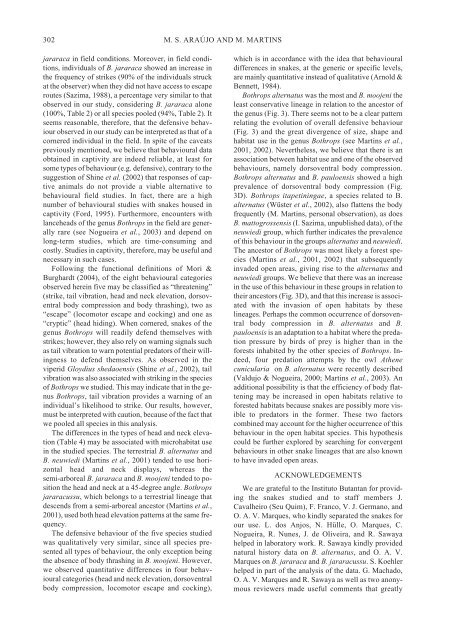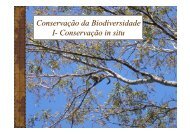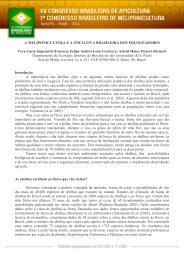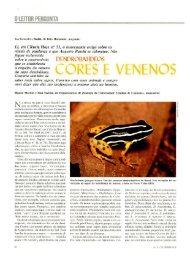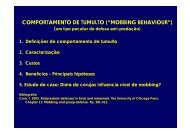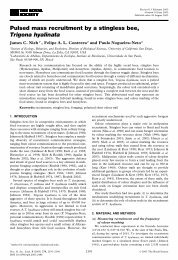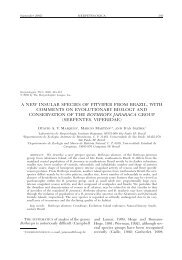Araujo & Martins pp 297-303.pmd - Ecologia
Araujo & Martins pp 297-303.pmd - Ecologia
Araujo & Martins pp 297-303.pmd - Ecologia
Create successful ePaper yourself
Turn your PDF publications into a flip-book with our unique Google optimized e-Paper software.
302<br />
M. S. ARAÚJO AND M. MARTINS<br />
jararaca in field conditions. Moreover, in field conditions,<br />
individuals of B. jararaca showed an increase in<br />
the frequency of strikes (90% of the individuals struck<br />
at the observer) when they did not have access to escape<br />
routes (Sazima, 1988), a percentage very similar to that<br />
observed in our study, considering B. jararaca alone<br />
(100%, Table 2) or all species pooled (94%, Table 2). It<br />
seems reasonable, therefore, that the defensive behaviour<br />
observed in our study can be interpreted as that of a<br />
cornered individual in the field. In spite of the caveats<br />
previously mentioned, we believe that behavioural data<br />
obtained in captivity are indeed reliable, at least for<br />
some types of behaviour (e.g. defensive), contrary to the<br />
suggestion of Shine et al. (2002) that responses of captive<br />
animals do not provide a viable alternative to<br />
behavioural field studies. In fact, there are a high<br />
number of behavioural studies with snakes housed in<br />
captivity (Ford, 1995). Furthermore, encounters with<br />
lanceheads of the genus Bothrops in the field are generally<br />
rare (see Nogueira et al., 2003) and depend on<br />
long-term studies, which are time-consuming and<br />
costly. Studies in captivity, therefore, may be useful and<br />
necessary in such cases.<br />
Following the functional definitions of Mori &<br />
Burghardt (2004), of the eight behavioural categories<br />
observed herein five may be classified as “threatening”<br />
(strike, tail vibration, head and neck elevation, dorsoventral<br />
body compression and body thrashing), two as<br />
“escape” (locomotor escape and cocking) and one as<br />
“cryptic” (head hiding). When cornered, snakes of the<br />
genus Bothrops will readily defend themselves with<br />
strikes; however, they also rely on warning signals such<br />
as tail vibration to warn potential predators of their willingness<br />
to defend themselves. As observed in the<br />
viperid Gloydius shedaoensis (Shine et al., 2002), tail<br />
vibration was also associated with striking in the species<br />
of Bothrops we studied. This may indicate that in the genus<br />
Bothrops, tail vibration provides a warning of an<br />
individual’s likelihood to strike. Our results, however,<br />
must be interpreted with caution, because of the fact that<br />
we pooled all species in this analysis.<br />
The differences in the types of head and neck elevation<br />
(Table 4) may be associated with microhabitat use<br />
in the studied species. The terrestrial B. alternatus and<br />
B. neuwiedi (<strong>Martins</strong> et al., 2001) tended to use horizontal<br />
head and neck displays, whereas the<br />
semi-arboreal B. jararaca and B. moojeni tended to position<br />
the head and neck at a 45-degree angle. Bothrops<br />
jararacussu, which belongs to a terrestrial lineage that<br />
descends from a semi-arboreal ancestor (<strong>Martins</strong> et al.,<br />
2001), used both head elevation patterns at the same frequency.<br />
The defensive behaviour of the five species studied<br />
was qualitatively very similar, since all species presented<br />
all types of behaviour, the only exception being<br />
the absence of body thrashing in B. moojeni. However,<br />
we observed quantitative differences in four behavioural<br />
categories (head and neck elevation, dorsoventral<br />
body compression, locomotor escape and cocking),<br />
which is in accordance with the idea that behavioural<br />
differences in snakes, at the generic or specific levels,<br />
are mainly quantitative instead of qualitative (Arnold &<br />
Bennett, 1984).<br />
Bothrops alternatus was the most and B. moojeni the<br />
least conservative lineage in relation to the ancestor of<br />
the genus (Fig. 3). There seems not to be a clear pattern<br />
relating the evolution of overall defensive behaviour<br />
(Fig. 3) and the great divergence of size, shape and<br />
habitat use in the genus Bothrops (see <strong>Martins</strong> et al.,<br />
2001, 2002). Nevertheless, we believe that there is an<br />
association between habitat use and one of the observed<br />
behaviours, namely dorsoventral body compression.<br />
Bothrops alternatus and B. pauloensis showed a high<br />
prevalence of dorsoventral body compression (Fig.<br />
3D). Bothrops itapetiningae, a species related to B.<br />
alternatus (Wüster et al., 2002), also flattens the body<br />
frequently (M. <strong>Martins</strong>, personal observation), as does<br />
B. mattogrossensis (I. Sazima, unpublished data), of the<br />
neuwiedi group, which further indicates the prevalence<br />
of this behaviour in the groups alternatus and neuwiedi.<br />
The ancestor of Bothrops was most likely a forest species<br />
(<strong>Martins</strong> et al., 2001, 2002) that subsequently<br />
invaded open areas, giving rise to the alternatus and<br />
neuwiedi groups. We believe that there was an increase<br />
in the use of this behaviour in these groups in relation to<br />
their ancestors (Fig. 3D), and that this increase is associated<br />
with the invasion of open habitats by these<br />
lineages. Perhaps the common occurrence of dorsoventral<br />
body compression in B. alternatus and B.<br />
pauloensis is an adaptation to a habitat where the predation<br />
pressure by birds of prey is higher than in the<br />
forests inhabited by the other species of Bothrops. Indeed,<br />
four predation attempts by the owl Athene<br />
cunicularia on B. alternatus were recently described<br />
(Valdujo & Nogueira, 2000; <strong>Martins</strong> et al., 2003). An<br />
additional possibility is that the efficiency of body flattening<br />
may be increased in open habitats relative to<br />
forested habitats because snakes are possibly more visible<br />
to predators in the former. These two factors<br />
combined may account for the higher occurrence of this<br />
behaviour in the open habitat species. This hypothesis<br />
could be further explored by searching for convergent<br />
behaviours in other snake lineages that are also known<br />
to have invaded open areas.<br />
ACKNOWLEDGEMENTS<br />
We are grateful to the Instituto Butantan for providing<br />
the snakes studied and to staff members J.<br />
Cavalheiro (Seu Quim), F. Franco, V. J. Germano, and<br />
O. A. V. Marques, who kindly separated the snakes for<br />
our use. L. dos Anjos, N. Hülle, O. Marques, C.<br />
Nogueira, R. Nunes, J. de Oliveira, and R. Sawaya<br />
helped in laboratory work. R. Sawaya kindly provided<br />
natural history data on B. alternatus, and O. A. V.<br />
Marques on B. jararaca and B. jararacussu. S. Koehler<br />
helped in part of the analysis of the data. G. Machado,<br />
O. A. V. Marques and R. Sawaya as well as two anonymous<br />
reviewers made useful comments that greatly


